

Finnish team devise nanomechanical microwave amplifier with near least possible noise generation. Software simulator tracks undersea noise pollution - tech - 14 June 2011. IT'S getting noisy beneath the waves.
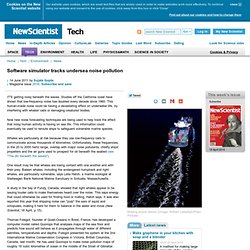
Studies off the California coast have shown that low-frequency noise has doubled every decade since 1960. This human-made noise could be having a devastating effect on underwater life, by interfering with whales' calls or damaging creatures' bodies. Now new noise forecasting techniques are being used to help track the effect that noisy human activity is having on sea life. This information could eventually be used to reroute ships to safeguard vulnerable marine species. Whales are particularly at risk because they use low-frequency calls to communicate across thousands of kilometres. Crystal oscillator. Quartz crystal resonator (left) and quartz crystal oscillator (right) A crystal oscillator is an electronic oscillator circuit that uses the mechanical resonance of a vibrating crystal of piezoelectric material to create an electrical signal with a very precise frequency.[1][2][3] This frequency is commonly used to keep track of time (as in quartz wristwatches), to provide a stable clock signal for digital integrated circuits, and to stabilize frequencies for radio transmitters and receivers.
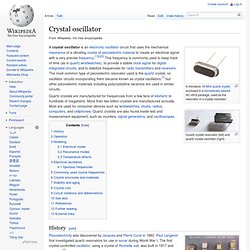
The most common type of piezoelectric resonator used is the quartz crystal, so oscillator circuits incorporating them became known as crystal oscillators,[1] but other piezoelectric materials including polycrystalline ceramics are used in similar circuits. Forgotten In Time: The Ancient Solfeggio Frequencies. Frequencies of Musical Notes.
Resonance. The goal of Unit 11 of The Physics Classroom Tutorial is to develop an understanding of the nature, properties, behavior, and mathematics of sound and to apply this understanding to the analysis of music and musical instruments.
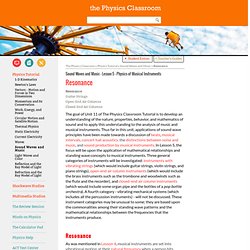
Thus far in this unit, applications of sound wave principles have been made towards a discussion of beats, musical intervals, concert hall acoustics, the distinctions between noise and music, and sound production by musical instruments. In Lesson 5, the focus will be upon the application of mathematical relationships and standing wave concepts to musical instruments.
Resonance As was mentioned in Lesson 4, musical instruments are set into vibrational motion at their natural frequency when a person hits, strikes, strums, plucks or somehow disturbs the object. Each natural frequency of the object is associated with one of the many standing wave patterns by which that object could vibrate. Infrasonic Sound. The term "infrasonic" applied to sound refers to sound waves below the frequencies of audible sound, and nominally includes anything under 20 Hz.
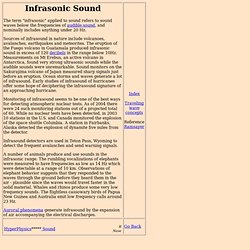
Sources of infrasound in nature include volcanoes, avalanches, earthquakes and meteorites. The eruption of the Fuego volcano in Guatamala produced infrasonic sound in excess of 120 decibels in the range below 10Hz. Measurements on Mt Erebus, an active volcano in Antarctica, found very strong ultrasonic sounds while the audible sounds were unremarkable. Sound monitors on the Sakurajima volcano of Japan measured sharp signals just before an eruption. Resonances of open air columns. Institut für Technische Akustik (ITA) - RWTH Aachen: Was ist Akustik? Dan Russell's Acoustics and Vibration Animations. Today is Thursday, March 8, 2018.
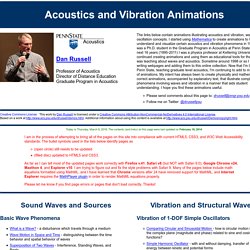
The contents (and links) on this page were last updated on February 18, 2014. I am in the process of attempting to bring all of the pages on this site into compliance with current HTML5, CSS3, and W3C Web Accessibility standards. The bullet symbols used in the lists below identify pages as (open circle) still needs to be updated (filled disc) updated to HTML5 and CSS3. As far as I can tell most of the updated pages work correctly with Firefox v.41, Safari v8 (but NOT with Safari 9.0), Google Chrome v24, Maxthon 4, and Explorer v10. Beerbottle. The Internet Bird Collection. Locative media. Locative media or Location-based media are media of communication functionally bound to a location.
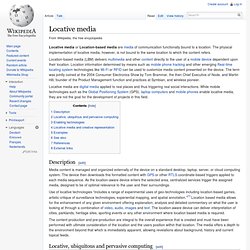
The physical implementation of locative media, however, is not bound to the same location to which the content refers. Location-based media (LBM) delivers multimedia and other content directly to the user of a mobile device dependent upon their location. Location information determined by means such as mobile phone tracking and other emerging Real-time locating system technologies like Wi-Fi or RFID can be used to customize media content presented on the device. The term was jointly coined at the 2004 Consumer Electronics Show by Tom Brammar, the then Chief Executive of Node, and Martin Hill, founder of the Product Management function and practices at Symbian, and wireless pioneer.
Making Maps with Sound. THIS IS WEIRD VIBRATIONS // the politics of sound. Above: “Soundshape Frame,” from the blog of the Institute for Advanced Architecture of Catalonia Above: Thomas Ashcraft’s recording of the invasion of Baghdad, 2003.

From Soundtransit.nl. Cymatics. Resonance made visible with black seeds on a harpsichord soundboard Cornstarch and water solution under the influence of sine wave vibration Cymatics (from Greek: κῦμα "wave") is the study of visible sound co vibration, a subset of modal phenomena.
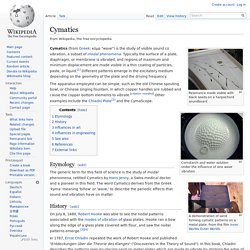
Erik Larson. Evan Grant: Making sound visible through Cymatics. Evan Grant a creative technologist, focuses on the idea of exploring nature by trying to find hidden data. He says that it seems there is latent potential everywhere. During this 2009 TED interview Grant demonstrates the science and art of Cymatics. Cymatics is a process for making sound waves visible. It is useful for analyzing complex sounds (like dolphin calls), it also makes complex and beautiful designs.
Evan Grant: Making sound visible through cymatics. Cymatics.org. Music visualization. Print screen of preset included in MilkDrop version 1.04d Visualization techniques range from simple ones (e.g., a simulation of an oscilloscope display) to elaborate ones, which often include a plurality of composited effects.
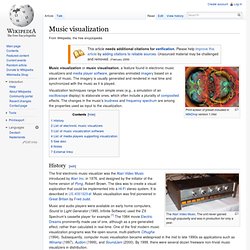
The changes in the music's loudness and frequency spectrum are among the properties used as input to the visualization. History[edit] The Atari Video Music. Sound Visualization Bowl pg 1. A Sound Visualization BowlThe idea for a Sound Visualization Bowl came from seeing a turned wooden bowl by Lee Sneddon entitled Tibetan Singing Bowl.

Singing Bowls work similarly to the effect you get when you run a dampend finger tip around the rim of a wine glass - only at lower tones. The sound a Singing Bowl makes is subtley complex, three to five different tones - sometimes synching up to create additional waxing and waning tones. The effect is quite hypnotic - which is why Singing Bowls are used in meditation. Looking for videos, with sound, of Singing Bowls I stumbled on one with Dancing Water.
Visualizing Sound - Course MCM 0750: Digital Art. Sounds permeate our senses everyday: Cars honking, cellphones buzzing, dogs barking, children screaming; sound is a ubiquitous presence in our lives. But how do we visualize, quantify, depict, and represent sound?